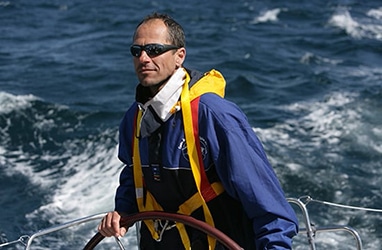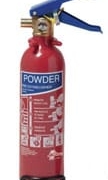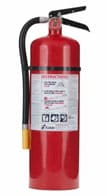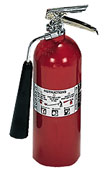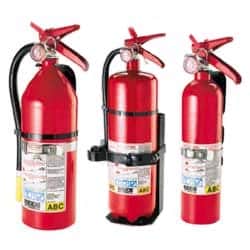Sailboat Fire Extinguishers and Requirements
Fire Extinguishers
Fire Extinguishers are given a letter rating that matches the type of fire they will be battling.
In North America, an A/B/C extinguisher can battle: combustible materials, flammable liquids, and gasses, and be applied to live electrical circuits.
In Europe, An A/B extinguisher can battle, combustible materials, flammable liquids, and gasses.
Additionally, each fire extinguisher also has a numerical rating that serves as a guide for the volume of the container’s contents; the higher the number, the longer it will dispense its content.
Knowing the source of a fire helps with determining the material with which to battle it.
- Water extinguishers or APW extinguishers (air-pressurized water) are suitable for class A fires only. Never use a water extinguisher on liquid or gas-fueled fires. The flames will spread and make the fire worse. Don’t use water on live electrical fires. Rather, shut off the electricity first then treat the fire appropriately. Water extinguishers should generally not be on sailing vessels because of this narrow spectrum of utility and danger in use against type B. If needed, obviously there is an ample supply of water via bucket from over the side. The advantage of water with fires is that water removes the heat from the fire. A good example of a class A fire requiring water would be if a mattress caught fire.
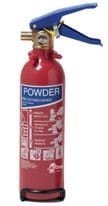 Dry chemical extinguishers come in a variety of types and depending on their classification, can be suitable for combustible materials, flammable liquids, and gasses, and are non-conductive. These are filled with foam or powder and pressurized with nitrogen. A key feature of dry chemical extinguishers is that the residue helps to prevent the re-ignition of fires because it will absorb heat. Another good feature is that it does not conduct electricity and is therefore particularly suitable for live electrical fires. This residue, however, is corrosive to metallic boat components and should be cleaned soon after the fire. The chemical tends to absorb heat and smother the fire by covering the area to prevent oxygen from gaining access to the fire. They are classified as:
Dry chemical extinguishers come in a variety of types and depending on their classification, can be suitable for combustible materials, flammable liquids, and gasses, and are non-conductive. These are filled with foam or powder and pressurized with nitrogen. A key feature of dry chemical extinguishers is that the residue helps to prevent the re-ignition of fires because it will absorb heat. Another good feature is that it does not conduct electricity and is therefore particularly suitable for live electrical fires. This residue, however, is corrosive to metallic boat components and should be cleaned soon after the fire. The chemical tends to absorb heat and smother the fire by covering the area to prevent oxygen from gaining access to the fire. They are classified as:
- BC (C designated in North America only; meaning the material is non-conductive) This dry chemical extinguisher combats flammable liquid and gas-fueled fires. It is filled with sodium bicarbonate or potassium bicarbonate. The BC variety leaves a mildly corrosive residue that must be cleaned immediately to prevent any damage to materials.
- ABC (C designated in North America only) This is the multipurpose dry chemical extinguisher (Figure 2) for battling Combustible materials, flammable liquid, and gas. Thus it is the most versatile type of extinguisher. The ABC type is filled with monoammonium phosphate, a yellow powder that leaves a sticky residue that may be damaging to electrical appliances such as a computer. Whenever a dry chemical extinguisher is used, the fire will probably be contained but you can count on a real mess to clean up. It’s important to clean up the chemical as soon as prudence allows because the damage it causes increases with time.
- BC (C designated in North America only; meaning the material is non-conductive) This dry chemical extinguisher combats flammable liquid and gas-fueled fires. It is filled with sodium bicarbonate or potassium bicarbonate. The BC variety leaves a mildly corrosive residue that must be cleaned immediately to prevent any damage to materials.
Figure 2: The A,B,C type of dry chemical fire extinguishers most commonly seen on boats.
- Carbon Dioxide (CO2) extinguishers are used for class B (and C fires). CO2 extinguishers contain carbon dioxide, a heavy, non-conductive, non-flammable gas, and are highly pressurized. They don’t work very well on class-A fires because they may not be able to absorb enough heat or displace enough oxygen to put the fire out. Re-ignition is then the danger. Exercise caution not to use CO2 extinguishers in enclosed areas, since they displace oxygen we need to breathe. However, these are well suited for use in a closed-engine room fire. CO2 extinguishers have an advantage over dry chemical extinguishers since they don’t leave a harmful residue. However, there is a disadvantage in that the CO2 does not absorb or remove the heat and thus can allow a reflash of the fire once the CO2 dissipates.
The operation of different fire extinguishers is fairly standardized. Once the extinguisher is released from its bracket, pull the pin at the top of the nozzle mechanism. While aiming at the base of the fire, squeeze the trigger to release the powder. Carefully and slowly, spray from side to side until the flames are out. Most extinguishers spray their contents for only about 10 seconds, so work efficiently. Once the fire is extinguished, watch the area for re-ignition. If the fire is uncontrollable, begin to abandon ship protocols.
Extinguisher Requirements and Recommendations
By law, a sailing vessel of a given size must have available a prescribed number of fire extinguishers. Many engine compartments now have automatic extinguisher systems that are activated by heat; these are highly recommended.
The table below is a recommendation for the type and number of fire extinguishers on your vessel. The numbers shown will exceed the legal requirements.
| Vessel Description | Vessel Typical Length | North America Type | Rest of the World Type |
| No engine. No galley. | Under 23 ft (7m) | Two ABC-I | Two 5A/34B |
| Outboard Engine. Galley. One bedroom. | 22 ft to 26ft |
One ABC-I for the bedroom. One ABC-I for the galley. One B-I for the engine. |
One 5A/34B for the bedroom. One 5A/34B for the galley. One 34B for the engine |
| Inboard engine. Galley. One bedroom. | 26 ft to 36 ft |
One ABC-I for the bedroom. One ABC-I for the galley. One ABC-II for salon area. One B-II for the engine compartment. |
One 8A/55B for the bedroom. One 8A/55B for the galley. One 13A/55B for the salon area. One 55B for the engine compartment |
| Inboard engine. Galley. Two bedrooms. | 28 ft to 40 ft |
One ABC-I for each bedroom. One ABC-I for galley. One ABC-II for salon area. One B-II for the engine compartment. |
One 8A/55B for each bedroom. One 8A/55B for the galley. One 13A/55B for salon area. One 55B for the engine compartment. |
| Inboard engine. Galley. Multiple bedrooms. | 40 ft plus |
One ABC-I for each bedroom. One ABC-I for the galley. One ABC-II for salon area. One B-II for the engine compartment. |
One 8A/55B for each bedroom. One 8A/55B for the galley. One 13A/55B for salon area. One 55B for the engine compartment. |
And buy big red stickers to display the location of the extinguishers for your crew. Durh!
Ever been to a clean bathroom in a restaurant? You can bet that they are the ones with a signed inspection routine posted on the wall. Do that to your boat—post a signed inspection sheet regarding your extinguishers. It’ll impress your crew and visitors. Add a note to the bottom to say, “If out of date, please inform the captain.”
Set up the routine for extinguisher inspection:
- Check the gauge monthly.
- For chemical types, remove and shake upside down twice a year to keep the chemicals mixed.
- Have the bottle weighed and professionally inspected annually.
The ultimate key in firefighting is to not hurt yourself or the crew. Be prepared to abandon ship if necessary and let your insurance take the loss.
Here is a good summary video from our friends at West Marine on types of fire extinguishers and what to put on your boat.

